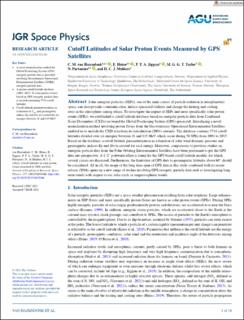| dc.contributor.author | van Hazendonk, Charlotte Maartje | |
| dc.contributor.author | Heino, Erkka Petteri | |
| dc.contributor.author | Jiggens, Piers T.A. | |
| dc.contributor.author | Taylor, Matthew G.G.T. | |
| dc.contributor.author | Partamies, Noora | |
| dc.contributor.author | Mulders, Hjalmar C. J. | |
| dc.date.accessioned | 2022-05-27T12:28:29Z | |
| dc.date.available | 2022-05-27T12:28:29Z | |
| dc.date.created | 2022-03-30T16:21:12Z | |
| dc.date.issued | 2022 | |
| dc.identifier.issn | 2169-9380 | |
| dc.identifier.uri | https://hdl.handle.net/11250/2996484 | |
| dc.description.abstract | Solar energetic particles (SEPs), one of the main causes of particle radiation in interplanetary space, can disrupt radio communication, induce spacecraft failures and change the heating and cooling rates in the atmosphere among others. To investigate the impact of SEPs and more specifically solar proton events (SPEs), we established a cutoff latitude database based on energetic particle data from Combined X-ray Dosimeters (CXDs) on board the Global Positioning System (GPS) spacecraft. Introducing a novel normalization method involving proton fluxes from the Geostationary Operational Environmental Satellites enabled us to include the CXD data from its introduction (2001) onwards. The database contains 5714 cutoff latitudes divided over six energies between 18 and 115 MeV which occur during 58 SPEs from 2001 to 2015. Based on the database, a cutoff latitude parameterization as a function of solar wind dynamic pressure and geomagnetic indices Kp and Dst is created for each energy. Moreover, comparisons to previous studies on energetic particle data from the Polar Orbiting Environmental Satellites have been performed to put the GPS data into perspective. A 1–2° poleward offset is found for the GPS based cutoff latitude models, for which several causes are discussed. Furthermore, the limitation of GPS data to geomagnetic latitudes above 60° should be considered. All in all, the usage of the long time span of GPS data in this study combined with its recent release (2016) opens up a new range of studies involving GPS energetic particle data such as investigating long-term trends with respect to our solar cycle or magnetospheric trends. | en_US |
| dc.language.iso | eng | en_US |
| dc.publisher | American Geophysical Union | en_US |
| dc.rights | Navngivelse-Ikkekommersiell 4.0 Internasjonal | * |
| dc.rights.uri | http://creativecommons.org/licenses/by-nc/4.0/deed.no | * |
| dc.title | Cutoff Latitudes of Solar Proton Events Measured by GPS Satellites | en_US |
| dc.type | Journal article | en_US |
| dc.type | Peer reviewed | en_US |
| dc.description.version | publishedVersion | en_US |
| dc.rights.holder | Copyright 2022 the authors | en_US |
| dc.source.articlenumber | e2021JA030166 | en_US |
| cristin.ispublished | true | |
| cristin.fulltext | original | |
| cristin.qualitycode | 2 | |
| dc.identifier.doi | 10.1029/2021JA030166 | |
| dc.identifier.cristin | 2013864 | |
| dc.source.journal | Journal of Geophysical Research (JGR): Space Physics | en_US |
| dc.relation.project | Norges forskningsråd: 287427 | en_US |
| dc.relation.project | Norges forskningsråd: 223252 | en_US |
| dc.identifier.citation | Journal of Geophysical Research (JGR): Space Physics. 2022, 127 (3), e2021JA030166. | en_US |
| dc.source.volume | 127 | en_US |
| dc.source.issue | 3 | en_US |

